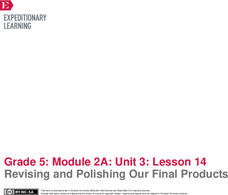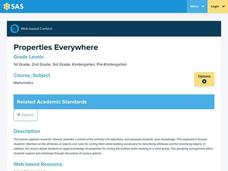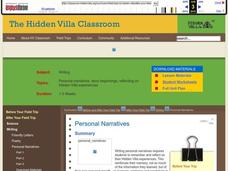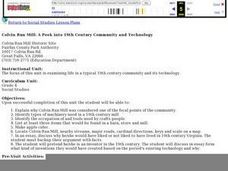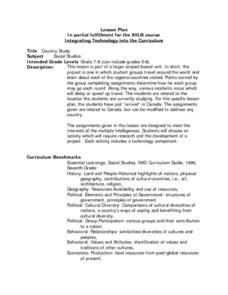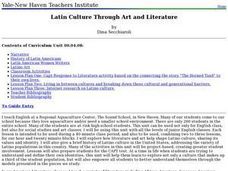EngageNY
Research: Paraphrasing Relevant Information
Readers take a look at the source Ethical Style: How Is My T-Shirt Made? and discuss how to say the information in the article without plagiarism. Learners make note of and underline sentences that may present a problem in paraphrasing....
EngageNY
Researching Digital Sources, Part 2: Guided WebQuest
Go surfing for the facts. Scholars continue their work using their Digital Resources on DDT sheet to find information by searching websites. After collecting information, they mix and mingle to hear information discovered by classmates.
EngageNY
Conducting Research: Analyzing a Variety of Sources to Capture Information about My Insect
From picture to words. Scholars analyze a picture of an ant and then list two facts they observed and any questions that may arise. Expert groups from the previous instructional activity then look at a diagram about either an ant or...
EngageNY
Writing Interview Questions
And now for the star witness! Scholars take a look at a model newspaper article and discuss the importance of eyewitness accounts. In groups of three, they take turns underlining text from eyewitnesses. They then regroup to talk about...
EngageNY
Resource Materials and Gathering Information: Reading Another “Choice” Text from the Research Folder
Look it up. Scholars use a dictionary and thesaurus to verify the meaning of the research vocabulary words they defined in the previous activity. They then use sticky notes to write a synonym for each word. Finally, individuals choose a...
EngageNY
Research Tasks: New Words, Relevant Information, Revision
Word builders. Scholars participate in a mini lesson about affixes. They then complete a research vocabulary organizer and share their definitions of the words with the class. They gather more evidence for their research from the...
EngageNY
Revising and Polishing Our Final Products
One, two, three go! Scholars work independently to finalize the three components of their final task. They complete a science journal entry, scientific text box, and scientific drawing. While working, learners sign up for an appointment...
Curated OER
Systems of Equations and Real Life
What a great classroom resource! The intention of this lesson is to show that real-world math can and should be applied to the community in which your students reside. The class relates properties of equations to solving for species...
Federal Reserve Bank
What Do People Say?
After reading a series of fictitious letters that represent actual events during the time period, young historians craft a small town newsletter to explain the causes of the Great Depression.
Curated OER
Tessellmaniacs
Seventh graders create 3 original tessellation using polygons. They slide, turn, rotate and glide their designs on the computer. They print their tessellation on a T-shirt and teach the 6th graders about tessellations.
Curated OER
A Death Record: 1860
Learners research death records in order to contrast causes of death in the past with those of today and compare the ages of death of males and females in the 1800s.
Pennsylvania Department of Education
Properties Everywhere
Students examine and sort objects by specific attributes and apply prior knowledge. For this properties everywhere lesson, students work in groups to arrange objects in categories then discuss various sorting options while...
Curated OER
Numeracy
Students review numbers, number systems and the number operations through the use of online webpages.
Curated OER
Personal Narratives
Students complete writing lessons to help students select a writing topic, prepare a writing plan, and create an interesting beginning. In this personal narratives lesson, students complete intensive modeling activities to write their...
Curated OER
Colvin Run Mill: A Peek into 19th Century Community and Technology
Fourth graders take a field trip to a mill, identify the parts of a mill, what was produced there, and what types of occupations were associated with a mill. They write an essay detailing the reasons they would or wouldn't like to have...
Curated OER
Science in baseball
Sixth graders examine how science is used in everyday activities, such as baseball.
Curated OER
Dissolved Oxygen and Photosynthesis: 1
Students are taught that plants produce oxygen underwater, and they design an experiment that test this question. They discuss whether plants give off oxygen, and how to measure this. Students measure the increase in dissolved oxygen...
Alabama Learning Exchange
J. Alfred Hyperbolizes
Mermaids will sing to your class members as they engage in an activity related to T.S. Eliot's famous dramatic interior monologue. After engaging in a socratic seminar about literary devices in the poem, individuals choose one...
Curated OER
The Ultimate Classroom: R & D
Redecorate a classroom on a budget. Middle schoolers rebuild a classroom after a disaster. They conduct Internet research to determine construction supplies needed and the most cost effective way to reach the predetermined results. They...
Curated OER
The U.S. Constitution: Practical Application of the Amendments
Students create their own HyperStudio cards which include scanned images of at least one member (designated reader) of each group. They add the text of a predetermined amendment. The designated reader then reads the selected amendment.
Curated OER
Immigration in Massachusetts, 1880-1920
Learners, in groups, research immigration in America at the turn of the century. They put together a series of original written essays, letters, newspaper columns, etc. that show what it was like to live as an American citizen and as an...
Curated OER
Quilting Bee-Assembly Line Style
Students identify the roles of a producer and a consumer. In this economics lesson, students define the roles of a consumer and producer and produce a quilt using an assembly line.
Curated OER
Social Studies: Countries and Technology
Students participate in a travel simulation and have just arrived in Canada. After choosing activities to research, they define their methods of exploration and development on plan sheets. Among the scenarios from which they choose...
Curated OER
Latin Culture Through Art and Literature
Eleventh graders participate in a lecture on the history of Latin Americans and the role of Latin-American women writers. As a class, they read a story together and identify what lessons the narrator gained throughout the story. In...








